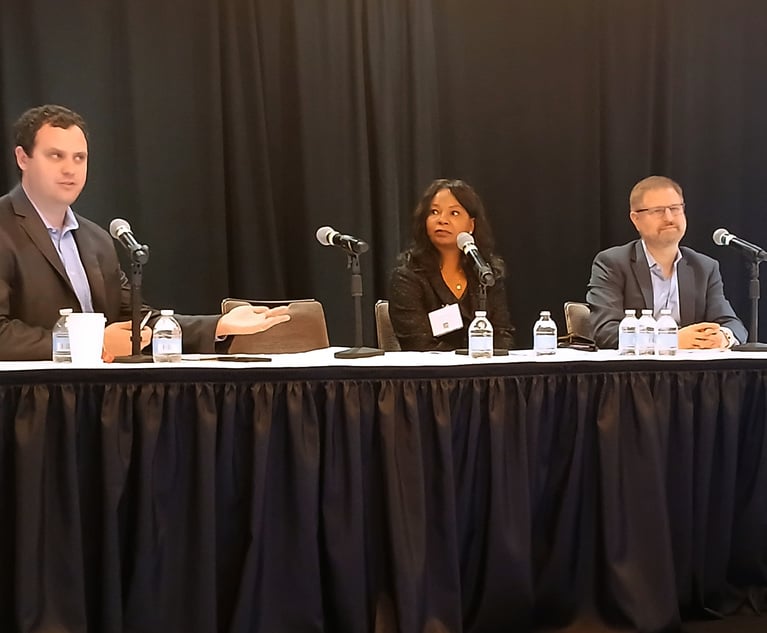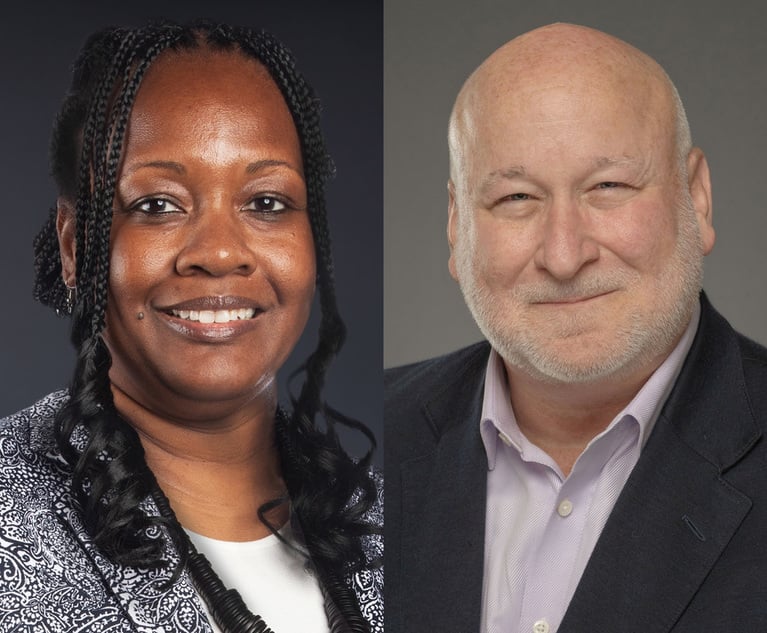“E-Merging”: Mergers and acquisitions in today’s era of big data
By 2020, it is projected that organizations will deal with fifty times more information than they are managing today.
April 12, 2013 at 07:43 AM
5 minute read
The original version of this story was published on Law.com
Corporate mergers and acquisitions are now making a comeback after a screeching halt during the global financial crisis. In 2013, this upswing coincides with the new realities of “Big Data” in corporate America. By 2020, it is projected that organizations will deal with fifty times more information than they are managing today. The combination of these situations—troves of digital records and more companies seeking governmental merger approval—creates the imperative that corporate counsel pay special attention to e-discovery practices, now more than ever before.
Before a Merger
One of the most critical aspects of a deal, as applied to e-discovery, is the process that is carried out before electronic documents are ever transmitted to the government for merger approval. Enormous data volumes present major challenges during mergers because parties in a transaction cannot close the deal (and thereby realize the efficiencies the deal will create) until they collect, process and review Item 4(c) and 4(d) documents during the pre-merger filing stage and substantially comply with a Second Request, if one is issued.
For that reason, any company engaged in the Hart-Scott-Rodino (HSR) pre-merger process will greatly benefit from having its data infrastructure in order. In short, if your company currently lacks a data management infrastructure, the time is ripe to develop one. Such activities in pursuit of a data management plan could include:
- Formation of a “response team” that will be responsible for managing the process of identifying and gathering electronic documents as necessary throughout the merger review process
- Identification of all electronic data locations via a “data map”
- An audit of existing preservation and litigation holds
- An examination of data storage systems for structured and unstructured data
During a Premerger Investigation
If the companies have engaged in the process of managing electronic documents early, as suggested above, then the burden of collecting, processing, reviewing, and producing 4(c) and 4(d) documents or responding to a Second Request is substantially reduced. To help minimize the burden of producing electronic documents:
- Be aggressive in negotiating the number and nature of custodians, the use of keyword lists, and the use of intelligent or predictive coding technology.
- Identify (and if necessary create a catalog of) email archive tapes and those tapes' schedule for re-use or destruction.
- Take advantage of technology, including innovative searching and categorization features in remote, online document repositories. Such technology can be especially useful in identifying documents responsive to Items 4(c) and 4(d) of the HSR filing, and other relevant documents that illustrate the competitive effects of the transaction.
- As documents are collected in response to the Second Request, be mindful of the possibility that the electronic data collected can be used to oppose the any attempt to block the deal. Identify and organize helpful and harmful documents.
- Be aggressive in requesting meetings with the government to address substantive competitive concerns and be prepared to support positions with documentary evidence and economic analysis.
In the unusual event that the government challenges the merging companies certification of substantial compliance with the Second Request, electronic document management becomes vitally important. If the parties to the transaction have been proactive and organized in their approach to electronic data throughout the review process, ediscovery will be much easier at this critical stage.
Further, it is important to note that today many merging companies have operations outside of the US, and in many deals there is a corresponding requirement outside the US for pre-merger notification and compliance similar to that required by the HSR Act in the US. The Canadian Competition Act, for example, amended in 2012 to align more closely with the US pre-merger regime, can result in issue of a Supplemental Information Request (SIR), which can be as or more document-intensive than an HSR second request.
Post-merger Approval
After substantially complying with a Second Request, ediscovery must remain a focus of post-merger integration planning to address any ongoing or subsequent holds or preservation orders in future litigation. In particular, the information infrastructures of the two companies should be seamlessly combined so as to ensure the safeguarding of all critical data. Whether one IT department takes over the other, or the two combine to form a larger department, it is important that the new data infrastructure allows for preservation while also discouraging inefficiencies caused by over-retention.
In sum, companies, especially those with mergers or acquisitions in their future, must anticipate the exponential growth of data volumes and tackle the issue head-on. While Big Data can certainly present a daunting challenge in the already-complicated process of competition law, its effective management can also be a useful tool in promoting an orderly completion of the pre-merger investigation process, as well as the merger itself.
This content has been archived. It is available through our partners, LexisNexis® and Bloomberg Law.
To view this content, please continue to their sites.
Not a Lexis Subscriber?
Subscribe Now
Not a Bloomberg Law Subscriber?
Subscribe Now
NOT FOR REPRINT
© 2024 ALM Global, LLC, All Rights Reserved. Request academic re-use from www.copyright.com. All other uses, submit a request to [email protected]. For more information visit Asset & Logo Licensing.
You Might Like
View All
Lawyers Drowning in Cases Are Embracing AI Fastest—and Say It's Yielding Better Outcomes for Clients

GC Conference Takeaways: Picking AI Vendors 'a Bit of a Crap Shoot,' Beware of Internal Investigation 'Scope Creep'
8 minute read
Why ACLU's New Legal Director Says It's a 'Good Time to Take the Reins'
Trending Stories
Who Got The Work
Michael G. Bongiorno, Andrew Scott Dulberg and Elizabeth E. Driscoll from Wilmer Cutler Pickering Hale and Dorr have stepped in to represent Symbotic Inc., an A.I.-enabled technology platform that focuses on increasing supply chain efficiency, and other defendants in a pending shareholder derivative lawsuit. The case, filed Oct. 2 in Massachusetts District Court by the Brown Law Firm on behalf of Stephen Austen, accuses certain officers and directors of misleading investors in regard to Symbotic's potential for margin growth by failing to disclose that the company was not equipped to timely deploy its systems or manage expenses through project delays. The case, assigned to U.S. District Judge Nathaniel M. Gorton, is 1:24-cv-12522, Austen v. Cohen et al.
Who Got The Work
Edmund Polubinski and Marie Killmond of Davis Polk & Wardwell have entered appearances for data platform software development company MongoDB and other defendants in a pending shareholder derivative lawsuit. The action, filed Oct. 7 in New York Southern District Court by the Brown Law Firm, accuses the company's directors and/or officers of falsely expressing confidence in the company’s restructuring of its sales incentive plan and downplaying the severity of decreases in its upfront commitments. The case is 1:24-cv-07594, Roy v. Ittycheria et al.
Who Got The Work
Amy O. Bruchs and Kurt F. Ellison of Michael Best & Friedrich have entered appearances for Epic Systems Corp. in a pending employment discrimination lawsuit. The suit was filed Sept. 7 in Wisconsin Western District Court by Levine Eisberner LLC and Siri & Glimstad on behalf of a project manager who claims that he was wrongfully terminated after applying for a religious exemption to the defendant's COVID-19 vaccine mandate. The case, assigned to U.S. Magistrate Judge Anita Marie Boor, is 3:24-cv-00630, Secker, Nathan v. Epic Systems Corporation.
Who Got The Work
David X. Sullivan, Thomas J. Finn and Gregory A. Hall from McCarter & English have entered appearances for Sunrun Installation Services in a pending civil rights lawsuit. The complaint was filed Sept. 4 in Connecticut District Court by attorney Robert M. Berke on behalf of former employee George Edward Steins, who was arrested and charged with employing an unregistered home improvement salesperson. The complaint alleges that had Sunrun informed the Connecticut Department of Consumer Protection that the plaintiff's employment had ended in 2017 and that he no longer held Sunrun's home improvement contractor license, he would not have been hit with charges, which were dismissed in May 2024. The case, assigned to U.S. District Judge Jeffrey A. Meyer, is 3:24-cv-01423, Steins v. Sunrun, Inc. et al.
Who Got The Work
Greenberg Traurig shareholder Joshua L. Raskin has entered an appearance for boohoo.com UK Ltd. in a pending patent infringement lawsuit. The suit, filed Sept. 3 in Texas Eastern District Court by Rozier Hardt McDonough on behalf of Alto Dynamics, asserts five patents related to an online shopping platform. The case, assigned to U.S. District Judge Rodney Gilstrap, is 2:24-cv-00719, Alto Dynamics, LLC v. boohoo.com UK Limited.
Featured Firms
Law Offices of Gary Martin Hays & Associates, P.C.
(470) 294-1674
Law Offices of Mark E. Salomone
(857) 444-6468
Smith & Hassler
(713) 739-1250







